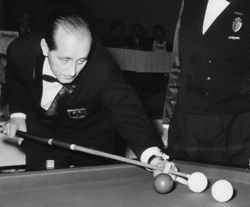German three-cushion championship 1939
| 11th German three-cushion championship 1939 |
|
|---|---|
| Winner Ernst Rudolph , his first of seven titles. | |
| Tournament dates | |
| Tournament type: | Ranking tournament |
| Tournament format: | Round robin |
| Organizer: | DABV |
| Tournament details | |
| Venue: | Berlin, German Empire |
| Opening: | March 19, 1939 |
| Endgame: | March 23, 1939 |
| Attendees: | 10 |
| Defending champion: | August Tiedtke |
| Winner: | Ernst Rudolph |
| 2nd finalist: | Willy Pesch |
| 3rd place: | Georg Berrisch |
| Prize money: | Amateur tournament |
| Records | |
| Best GD: | 0.682 Willy Pesch |
| Best ED: | 0.909 Willy Pesch |
| Maximum series (HS): |
8 • Willy Pesch • Georg Berrisch |
| Venue on the map | |
| ← 1938 | 1940 → |
The German Three Cushion Championship 1939 (DDM) was the tenth edition of this tournament series and took place from March 19 to 23 in Berlin .
history
The number of participants rose to ten for the first time. It was the last championship before the start of the war. Due to the annexation of Austria , Franz Engl from Vienna was able to take part in the tournament. The National Socialist sports policy had other effects. So the best German three-cushion player, August Tiedtke , could not start because on February 8, 1939, for two years "because of his unworthy of a German amateur and the concerns of the association-damaging behavior in Buenos Aires ... and because of gross violations of sports and association discipline" has been blocked by DABV. This was arranged by the Reich Sports Leader Hans von Tschammer und Osten (for more information see article A. Tiedtke)
Ernst Rudolph , father of Christian Rudolph , took part for the first time and was immediately successful. However, he had to wait until 1955 to be able to stand on top of the podium again, as Tiedtke had to think about it in the following years. This time Unshelm did not have the luck of the better general average (GD) as in 1935 and 1938 and this time only achieved fourth place despite the tie in points. He also had to bow to Tiedtke's skill level in the following years, but was able to beat him again in 1941 and win the game. The strongest player, however, was the runner-up Willy Pesch. He was able to book all three tournament records for himself, although he had to share the record of the highest series (HS) of eight points with Georg Berrisch. Albin Lischke (born January 19, 1890) from Berlin also took part for the first time. Lischke had a fatal accident on October 29, 1939.
mode
It was played in two groups of five players “everyone against everyone” ( round-robin mode ) on 50 points with a kick. Eight players made it to the final round, also in round robin mode.
Closing table
|
|
||||||||||||||||||||||||||||||||||||||||||||||||||||||||||||||||||||||||||||||||||||||||||||||||||||||||||||||||||||||||||
Individual evidence
- ^ Unpolitical: The billiard player August Tiedtke. Excerpt from: Sabine Gerasch: History from the tape. 1st edition. de Gruyter, 1997, ISBN 3-11-015274-6 , pp. 154-162.
- ^ A b Dieter Haase, Heinrich Weingartner : Encyclopedia of Billiards . 1st edition. tape 2 . Verlag Heinrich Weingartner, Vienna 2009, ISBN 978-3-200-01489-3 , p. 932 .
- ^ Robert Court: German Billard Newspaper . Ed .: DABV. tape 19 , no. 4 . Wuppertal April 1939, p. 56-57 .



